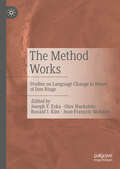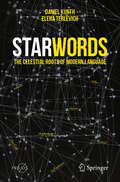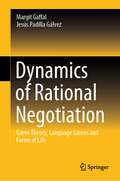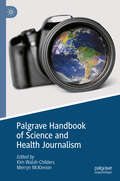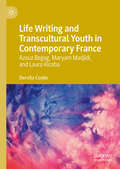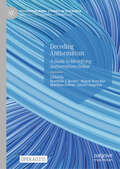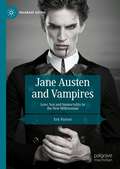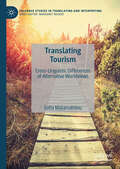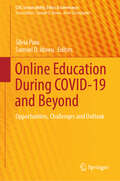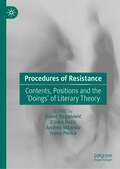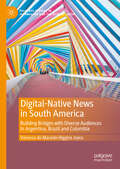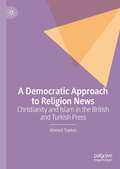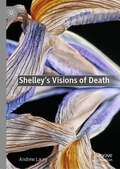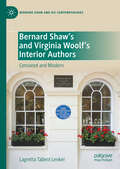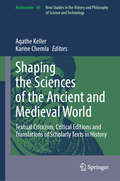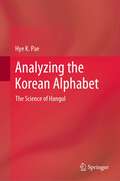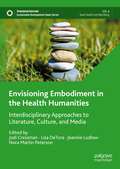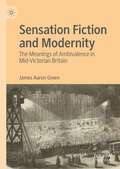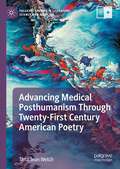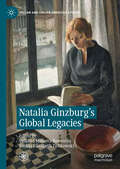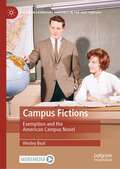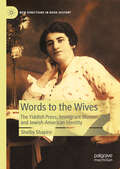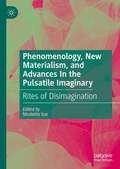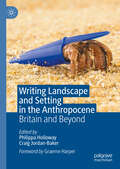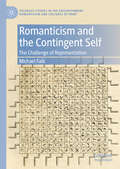- Table View
- List View
The Method Works: Studies on Language Change in Honor of Don Ringe
by Joseph F. Eska Jean-François Mondon Olav Hackstein Ronald I. KimThis volume contains an introductory essay, the bibliography of Professor Ringe, and nineteen articles on various aspects of historical linguistics composed by current and former colleagues and students at the University of Pennsylvania and a select number of leading scholars in the field based at institutions such as Cornell University, Harvard University, Oxford University, Saarland University, University of Georgia, University of California at Los Angeles, University of Munich, and York University. The majority of contributions focus upon linguistic phylogenetics (the interrelationships among languages), Classical linguistics, and Germanic linguistics. Many of the contributions make contributions to theoretical, as well as historical, linguistics.
StarWords: The Celestial Roots of Modern Language (Springer Praxis Books)
by Daniel Kunth Elena TerlevichUnbeknownst to many, our modern language contains countless words that were inspired by human observations of the cosmos. We now use words like “zenith”, “Monday”, “disaster”, “dog days”, “starfish”, “lunatic”, flu, and so many others, without a second thought for their celestial roots. Famous French astrophysicist Daniel Kunth invites you on a linguistic and scientific journey through space and time to explore these forgotten origins. You will be astonished to rediscover cosmic language hidden in plain sight through this wonderful collection of historical and cultural stories, famous idioms and delightful puns, along with the real science behind each one. Elena Terlevich is a well known professional astronomer working at INAOE in Mexico, an honorary Professor at La Plata University in Argentina and a regular visitor at the Institute of Astronomy in Cambridge (UK). Requiring no prior knowledge in astronomy or linguistics, this book’s universal contentsinvite the reader to ponder how our observations of the night sky have shaped our modern tongue and customs.
Dynamics of Rational Negotiation: Game Theory, Language Games and Forms of Life
by Margit Gaffal Jesús Padilla GálvezThis book uses game theory to analyze the strategies developed in negotiation processes. Offering a detailed analysis of competition and cooperation, it explores various bargaining strategies that result from the application of Nash equilibrium and mixed strategies. Employing a blend of game theory and real-world examples, the authors describe typical negotiation scenarios and unveil the art of negotiation strategy – dissecting both competitive and cooperative tactics.This comprehensive analysis explores the multifaceted dimensions of negotiation, highlighting not only formal aspects but also the economic, social, political, and human factors at play. The authors discuss the basic structures of cooperative and non-cooperative games and conduct a comprehensive analysis of the language games that take place in negotiations. They examine how negotiators belonging to different forms of life can trade with each other when their respective language games are different and prone to misinterpretation. The book also probes arbitration and mediation as conflict-resolution tools within this intricate landscape. Designed for the curious minds seeking insight into negotiation strategies, as well as students and scholars of diverse fields, this book fosters an understanding of negotiation's labyrinthine pathways. "Dynamics of Rational Negotiation" unlocks the door to negotiation's complexities, inviting readers to unravel the layers of human interaction.
Palgrave Handbook of Science and Health Journalism
by Kim Walsh-Childers Merryn McKinnonThis handbook reviews the extant literature on the most important issues in health and science journalism, with a focus on summarizing the relevant research and identifying key questions that are yet to be answered. It explores challenges and best practices in health and science reporting, formats and audiences, key topics such as climate change, pandemics and space science, and the ethics and political impacts of science and health journalist practice. With numerous international contributions, it provides a comprehensive overview of an emerging area of journalism studies and science communication.
Life Writing and Transcultural Youth in Contemporary France: Azouz Begag, Maryam Madjidi, and Laura Alcoba
by Dervila CookeThis book analyses transcultural works of life writing relating to youth and childhood by Azouz Begag, Maryam Madjidi, and Laura Alcoba, of Algerian, Iranian, and Argentinian heritage respectively. With a strong focus on societal issues in France from the turn of the millennium to early 2024, including the intersections between the postcolonial and the transcultural, it analyses the authors’ relationship with France and the “home” country, and the problematic pull of return. Each author uses life writing in a transpersonal manner, and expresses multiple cultural belongings. Begag displays playful yet compulsive self-reinvention, Madjidi uses autofiction in a search for authenticity, and Alcoba’s approach highlights the difficulties of dealing with traumatic personal and national memory. A substantial overview is given of each author’s œuvre, along with societal context for the country of origin or descent, followed by close textual analysis. This is a companion volume to Dervila Cooke’s 2024 monograph on Québec.
Decoding Antisemitism: A Guide to Identifying Antisemitism Online (Postdisciplinary Studies in Discourse)
by Matthew Bolton Matthias J. Becker Hagen Troschke Alexis ChapelanThis open access book is the first comprehensive guide to identifying antisemitism online today, in both its explicit and implicit (or coded) forms. Developed through years of on-the-ground analysis of over 100,000 authentic comments posted by social media users in the UK, France, Germany and beyond, the book introduces and explains the central historical, conceptual and linguistic-semiotic elements of 46 antisemitic concepts, stereotypes and speech acts. The guide was assembled by researchers working on the Decoding Antisemitism project at the Centre for Research on Antisemitism at Technische Universität Berlin, building on existing basic definitions of antisemitism, and drawing on expertise in various fields. Using authentic examples taken from social media over the past four years, it sets out a pioneering step-by-step approach to identifying and categorising antisemitic content, providing guidance on how to recognise a statement as antisemitic or not. This book will be an invaluable tool through which researchers, students, practitioners and social media moderators can learn to recognise contemporary antisemitism online – and the structural aspects of hate speech more generally – in all its breadth and diversity.
Jane Austen and Vampires: Love, Sex and Immortality in the New Millennium (Palgrave Gothic)
by Eric ParisotJane Austen and Vampires is the first book to investigate the literary convergence of Jane Austen and vampires in Austen fanfic after the success of Stephenie Meyer’s Twilight (2005) and Seth Grahame-Smith’s Pride and Prejudice and Zombies (2009). It asks how the shifting cultural values of Austen and the vampire have aligned, and what their connection might mean for their respective contemporary legacies. It also makes a case for reading “low brow” Austen fanfic attentively, as a way to gain meaningful insight directly from Austen fans into the tensions and anxieties surrounding contemporary notions of love, sex, femininity, and Austen’s modern currency. Offering close readings of Austen’s vampire-slaying heroines, vampiric retellings of Pride and Prejudice, and the transformation of Austen herself into a vampire, this book reveals Austen-vampire mashups as messy, complex entanglements that creatively and self-reflexively interrogate modern fantasies of vampire romance. By its unique intersection of Jane Austen with the vampire, the Gothic, fan culture and popular romance, Jane Austen and Vampires adds a new chapter to the history of Austen’s reception, for fans, students and scholars alike.
Translating Tourism: Cross-Linguistic Differences of Alternative Worldviews (Palgrave Studies in Translating and Interpreting)
by Sofia MalamatidouThis book provides a large-scale empirical multilingual study of crosslinguistic differences in the language of destination promotion. The book explores how tourism texts are negotiated in translation, and how the translated texts reflect and reconcile different worldviews, that of the destination population and that of the tourist. Using the 2-million-word TrAIL (Tourism Across and & In-between Languages) corpus, which includes examples from official tourism websites in English, French, Greek, and Russian as well as translations between these languages, the author explores the differences in the key linguistic means used in destination promotion and what these linguistic choices can tell us about how these societies view the world around them differently. The book’s interdisciplinary focus makes it relevant to not only practising translators, but also students and scholars interested in issues surrounding tourism, promotion, and translation, as well as destination promoters who want to better understand the role that language and translation play in tourism promotion.
Online Education During COVID-19 and Beyond: Opportunities, Challenges and Outlook (CSR, Sustainability, Ethics & Governance)
by Samuel O. Idowu Silvia PuiuThis book aims to provide sustainable solutions for better understanding and management of online education in different parts of the world. In this context, it explores the attitudes and perceptions of stakeholders, such as students, faculty, and other actors on issues related to online education. In particular, it examines the challenges they have faced over the years when online courses were introduced due to the COVID-19 pandemic. A model is proposed that includes five variables: specific communication issues in online education, the ability of professors to offer online courses, the quality of online education, students' perceived stress during online education, and the technical requirements of online education.The book will be of interest to anyone concerned with the new and future ways of teaching and learning.Chapter “When a Phenomenon-Based University Course Went Online: Students’ Experiences and Reflections After Sauna Bathing” is available open access under a Creative Commons Attribution 4.0 International License via link.springer.com.
Procedures of Resistance: Contents, Positions and the 'Doings' of Literary Theory
by Zrinka Božić Davor Beganović Andrea Milanko Ivana PericaThis volume explores the state of literary theory today, decades after the repeatedly proclaimed end of theory. It builds on the idea that theory is historically constituted as it is “always becoming something else” as Leslie Fiedler claimed in the 1950s, arguing that the historical constitution of theory relies on theory’s procedural nature. In order to assess theory’s procedural challenge to the fundamental notions that all the disciplines within an episteme have brought to the fore, it addresses these questions: What are the procedures theory has relied on? Are they a secret to its resistance, or is resistance its primary procedure? And if so, a resistance to what? Secondly, if resistance were theory’s principal vehicle, at which point does resistance, conceptualized only procedurally (as resisting something, questioning anything, criticizing whatever), display hallmarks of a disciplinary closure that must call for new resistances, and perhapsfor a fundamentally another kind? The book turns to what theory does in order to avoid a partial answer to what theory is.
Digital-Native News in South America: Building Bridges with Diverse Audiences in Argentina, Brazil and Colombia (Palgrave Studies in Journalism and the Global South)
by Vanessa de Macedo Higgins JoyceThis book investigates the strategies used by South American digital-native news media in attracting diverse audiences, and their effectiveness, from an audience perspective, in bridging communities and building consensus.In recent years, independent digital news outlets have emerged in a landscape of increasing ideological polarization. The book addresses the pivotal question of whether these organizations can help promote social cohesion and overcome a divided and fragmented market. Drawing from extensive interviews conducted with audience members, journalists, and media executives from the established news markets of Argentina, Brazil and Colombia, de Macedo Higgins Joyce sheds new theoretical insights on the strategies and practice of independent digital news, its evolution, and its agenda-setting impact in the region.Innovative and rigorous, Digital-Natives News in South America deftly explores this new and important field of research and will be of interest to journalism researchers and media practitioners alike.
A Democratic Approach to Religion News: Christianity and Islam in the British and Turkish Press
by Ahmed TopkevThis book introduces the first systematic and unified four-dimension democratic approach to newspaper religion reporting. It explores the coverage of faith, with a particular focus on Christianity and Islam, in the British and Turkish national press. The results of framing analysis, conducted through content analysis of 1,022 news articles, reveal that, in both countries, alongside the contrasting portrayals of the minority religions, even the dominant religions had a disproportioned employment of the four dimensions – spiritual, world life, political, and conflict. It contributes to scholarship not only empirically but also theoretically and methodologically, with its theoretical and methodological contribution surpassing its empirical findings. As such, it will transcend geographical and temporal boundaries, making it appealing and relevant to an international audience of academics, professionals, and students in the fields of journalism, religion, democracy, media, communication, society, and culture, as well as individuals from various backgrounds.
Shelley's Visions of Death
by Andrew LaceyThis book provides the first modern, in-depth analysis of Percy Bysshe Shelley’s engagement with the phenomenon of death. It argues that, for Shelley, this most nebulous of realities represents, first and foremost, possibility: Shelley’s poetic writings on death are both numerous and varied, presenting his reader, with differing degrees of confidence over the course of his brief but brilliant career, with several key visions of what death might be or actually is. Shelley’s Visions of Death stresses the seldom-appreciated fact that death was one of Shelley’s most enduring preoccupations, and also demonstrates the poet’s power to imagine, with startling variety, that which lies beyond the boundaries of experience.
Bernard Shaw’s and Virginia Woolf’s Interior Authors: Censored and Modern (Bernard Shaw and His Contemporaries)
by Lagretta Tallent LenkerVirginia Woolf and Bernard Shaw may be the odd couple of Twentieth Century modernism. Despite their difference in age (Shaw was twenty-six years older than Woolf), and public demeanor - Shaw sought public attention while Woolf shunned the spotlight - they actively held similar convictions on most of the pressing and controversial issues of the day. This book demonstrates that both engaged in social reform through the Fabian Society; both took public anti-war positions and paid dearly for it; both fought British censorship throughout most of their careers as writers; both sought to strengthen women’s rights; and both endeavored to revolutionize their respective art forms, believing that art could bring about positive social change. The main focus of the book, however, concerns how both also created interior authors - characters who write and who either self-censor their own works or highly publicized messages or are censored by their fellow characters. These fictional authors maybe considered reflections of their creators and their respective milieus and serve to illuminate the satisfactions and torments of each famous author during the writing process.
Shaping the Sciences of the Ancient and Medieval World: Textual Criticism, Critical Editions and Translations of Scholarly Texts in History (Archimedes #69)
by Karine Chemla Agathe KellerThis book contributes to a worldwide history of textual criticism and critical editions of ancient scientific texts. It first looks at ancient editorial practices, and at their impact on modern editions. Contributions analyze how, through time, the perception of what a text was may have changed, and influenced how scholarly texts were made accessible. The second section looks at the historical, political and social contexts within which editions and translations of ancient scientific texts were produced. Finally, the last two parts examine the specificities of editions and translations that bore on scholarly documents. Not only is there a focus on how the elements specific to scientific texts—such as diagrams and numbers—were treated, but case studies analyzing the specific work carried out to edit mathematical and astronomical texts of the past are also offered to the reader. The scholarship displayed in this work lays the foundation for further studies on the history of critical editions and raises questions to those who make scholarly translations and critical editions today.
Analyzing the Korean Alphabet: The Science of Hangul
by Hye K. PaeThis book provides comprehensive coverage of the Korean alphabet, Hangul, and includes a synthesis of research findings relating to reading in the non-Roman alphabet. This, in turn, contributes to the science of reading through an understanding of reading mechanisms that are essential for all writing systems, and that are particular for a given writing system. Hangul has been recognized as “the world’s best alphabet,” “one of the great intellectual achievements of Mankind,” and “alphabet’s epitome, a star among alphabets” by international linguists and historians. It is known that writing systems have evolved based on the ecological principle that visual signs are culturally selected to match objects found in natural scenes through selection pressures for optimal visual processing. However, Hangul is an exception. It was purposely invented by King Sejong in the 15th century to combat the illiteracy prevalent at the time. The chapters excavate the historical background of Hangul, and the unique characteristics of Hangul that contribute to learnability for emergent readers and efficiency for skilled readers. The author presents empirical evidence of psycholinguistic research into reading Hangul, building theories and presenting implications for the science of reading (psycholinguistics) and the science of writing (grapholinguistics). This book is relevant to students, researchers, and practitioners in applied linguistics, psycholinguistics, language studies, reading studies, and grammatology, with a particular focus on the Korean alphabet.
Envisioning Embodiment in the Health Humanities: Interdisciplinary Approaches to Literature, Culture, and Media (Sustainable Development Goals Series)
by Nora Martin Peterson Jodi Cressman Lisa DeTora Jeannie LudlowEnvisioning Embodiment in the Health Humanities: Literature, Culture, and Media examines discourses of embodiment across disability studies, gender studies, cultural studies, and visual studies to inform educational practice as well as cultural criticism related to the health and medical humanities. The book argues that imagery and other visual elements in literature, comics, lived experience and the arts demonstrate the hybridity of the embodied experience and identity and have something to offer to clinical practice. Connected to the UN Sustainable Development Goals 3 (Health), 4 (Gender equality), and 16 (Strong institutions), the topics addressed in the essays include mental health, grief, COVID-19, healthcare practices, cancer, and women’s health. The volume is designed to be accessible to advanced undergraduate students as well as graduate students and to be useful for medical practitioners and others who are interested in the health humanities, disability studies, gender studies, or cultural studies.
Sensation Fiction and Modernity: The Meanings of Ambivalence in Mid-Victorian Britain
by James Aaron GreenThis book re-reads the relationship between the Victorian sensation novel and modernity. Whereas critics have long recognized its appearance in the form of nervous subjects and technologically-enabled mobility, Green contends that sensation fiction also depicts modernity in the form of intellectual and moral discontinuity. Through closely historicist readings of novels by Wilkie Collins and Mary Elizabeth Braddon, as well as by Joseph Sheridan Le Fanu and Rhoda Broughton, this book traces how discontinuity is manifested in the suspenseful plotting of these fictions, through which readers are challenged to revise conventional assumptions about the world and adopt more contingent perspectives. The study demonstrates that reading for this sense of modernity does not merely uncover the genre's engagements with various mid-century contexts. More fundamentally, it broaches a new sense of the function and significance of sensation fiction: the acclimatization of its readers to the discontinuities of modern existence.
Advancing Medical Posthumanism Through Twenty-First Century American Poetry (Palgrave Studies in Literature, Science and Medicine)
by Tana Jean WelchAdvancing Medical Posthumanism Through Twenty-First Century American Poetry places contemporary poetics in dialogue with posthumanism and biomedicine in order to create a framework for advancing a posthuman-affirmative ethics within the culture of medical practice. This book makes a case for a posthumanist understanding of the body—one that sees health and illness not as properties possessed by individual bodies, but as processes that connect bodies to their social and natural environment, shaping their capacity to act, think, and feel. Tana Jean Welch demonstrates how contemporary American poetry is specifically poised to develop a pathway toward a posthuman intervention in biomedicine, the field of medical humanities, medical discourse, and the value systems that guide U.S. healthcare in general.
Natalia Ginzburg's Global Legacies (Italian and Italian American Studies)
by Saskia Elizabeth Ziolkowski Stiliana Milkova RoussevaOffering comparative and interdisciplinary approaches to Natalia Ginzburg, this volume situates Ginzburg’s works within major critical discourses to articulate innovative readings and mobilize further lines of inquiry. The first section, “World Literature and World Making,” uses translation practices, world literature, and transnational studies to theorize the growing popularity of Ginzburg. The second section, “Female Bodies, Voices, and Gazes,” draws on gender and queer studies, speech act theory, intersectional feminism, and media studies to begin to address gaps in Ginzburg scholarship. The last section, “Identity, Topography, and Forms,” approaches Ginzburg through the lenses of trauma studies, topography, novel and essay studies, and Jewish identity. Natalia Ginzburg’s Global Legacies both makes available in English important Italian research and builds on significant international discourses. In bridging Italian and Anglophone scholarship, the volume engages students and scholars of Comparative and Italian literature, world literature, and women’s writing, as well as general readers of Ginzburg.
Campus Fictions: Exemption and the American Campus Novel (American Literature Readings in the 21st Century)
by Wesley BealCampus Fictions argues that the academic novel balances utopian and regressive tendencies, reinforcing the crises we face in higher learning while simultaneously signposting hope for a worn institution. Whether a bestseller such as Erich Segal ’s romance Love Story (1970) or wonkier fare such as Don DeLillo’s White Noise (1985), the academic novel mystifies the academy not only to a wide public but also—worse—to readers who might describe themselves as sympathetic to higher learning. The book takes an eclectic approach to the academic novel with chapters discussing, for example, the genre’s rampant anti-intellectualism and its work refusals, studying novels such as Ishmael Reed’s Japanese by Spring (1993) and Julie Schumacher’s Dear Committee Members (2014). The book is also accompanied by the “Directory of the American Campus Novel ” file, which tracks the genre by year, by setting, and by other datapoints that readers might make use of. Responding directly to Jeffrey Williams, the renowned scholar of critical university studies who implores faculty to “teach the university,” the book ’s conclusion describes strategies for putting these novels into circulation in the classroom. Through this breadth, Campus Fictions establishes the importance of maintaining hope in the field of critical university studies, which tends toward apocalypticism and perhaps therefore toward disengagement.
Words to the Wives: The Yiddish Press, Immigrant Women, and Jewish-American Identity (New Directions in Book History)
by Shelby ShapiroThis book looks at how the Yiddish press sought to create Jewish-American identities for immigrant women. Shelby Shapiro focuses on two women’s magazines and the women’s pages in three daily newspapers, from 1913, when the first Yiddish women’s magazine appeared, until 1925, when the Immigration Act of 1924 took effect. Shapiro demonstrates how newspaper editors and publishers sought to shape identity in line with their own religious or political tendencies in this new environment, where immigrants faced a broad horizon of possibilities for shaping or reshaping their identities in the face of new possibilities and constraints. External constraints included the economic situation of the immigrants, varying degrees of antisemitism within American society, while internal constraints included the variable power of traditions and beliefs brought with them from the Old World. Words to the Wives studies how publications sought to shape the direction of Eastern European Jewish immigrant women's acculturation.
Phenomenology, New Materialism, and Advances In the Pulsatile Imaginary: Rites of Disimagination
by Nicoletta IsarPhenomenology, New Materialism, and Advances In the Pulsatile Imaginary: Rites Of Disimagination brings together scholars from art history and image theory, literary studies and philosophy. Chapters of this volume engage with the overarching theme of imagination as a pulsatile force embedded in words, images, and all imaginative modes of instantiation of the work of art in their elemental aspects, expressed in visual arts, and literature, as well as bodily schemata of choreographic and musical performances. The papers employ contrasting and complementing methods from literary studies and image theory, especially phenomenology and new materialism, such as G. Bachelard and M. Merleau-Ponty, G. Bataille, J. Kristeva, P. Lacoue-Labarthe and J. Sallis, G. Didi-Huberman, H. Belting and A. Warburg, J. Bennett and Jason M. Wirth, as well as performance studies. Chapters in this volume inquire into the imaginative forces that disrupt and disinhibit the traditional habits ofimagination to create pulsatile imaginaries, i.e., a dynamic process of “emergence-resurgence” of image manifested in the act of creation and in perception. This process does not properly imply a destruction of image, but rather a withdrawal of image from the realm of representation to give way to new images and new imaginative experiences. The newly coined term “rite of disimagination” points out to this operation, consecutively implying imagining and disimaging that both denies, as well as validates image – it valorizes matter. The affirmation of the materiality of image is “the re-incarnation of image.”
Writing Landscape and Setting in the Anthropocene: Britain and Beyond
by Philippa Holloway Craig Jordan-BakerThis edited collection offers an in-depth exploration of the role of landscape and place as literary ‘settings’. It examines the multifaceted relationships between authors, narrators, and characters to their locales, as well as broader considerations of the significance of the representation of landscape in a world deeply affected by human interventions. Consisting of case studies of projects that engage with these questions, as well as research examining the theoretical underpinnings of both creative practices/processes and post-textual analysis of published works, this volume is both multidisciplinary and interdisciplinary in scope. In the context of the climate crisis and a pandemic which has caused us to re-evaluate the significance of landscape and the environment, it responds to the need to engage current trends within the academy and in broader social debate about our relationship to the natural world.
Romanticism and the Contingent Self: The Challenge of Representation (Palgrave Studies in the Enlightenment, Romanticism and Cultures of Print)
by Michael FalkThis book offers a new critique of selfhood in Romantic literature. In the past, Romanticism has been seen as an individualistic movement, with writers believing in the ‘centrality’ of the self. Challenging this prevailing view of Romanticism and the modern self, this study unveils an alternative tradition of Romantic writing in which the self is fragile, degenerate, non-existent – or in a word, contingent. It combines philosophy, intellectual history, literary studies and digital humanities and takes a transnational approach both in its coverage of philosophical thought and literature, including case studies from England, Ireland, Scotland and colonial Australia, with examples from American and European works as well. The book also uses innovative digital techniques such as text analysis, sentiment mining and network analysis to enrich the exploration of text and context. It covers all major genres of Romantic writing: fiction (realist novels), poetry (the sonnet), non-fiction prose (biography) and drama (gothic tragedy). Providing a new framework for understanding the contingent self, this book is of interest to scholars and students of Romantic literature, philosophy of the self and digital humanities.
